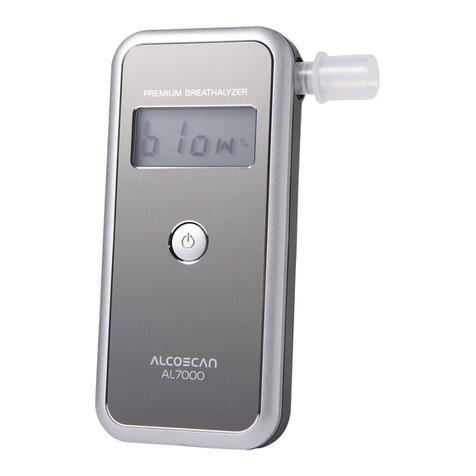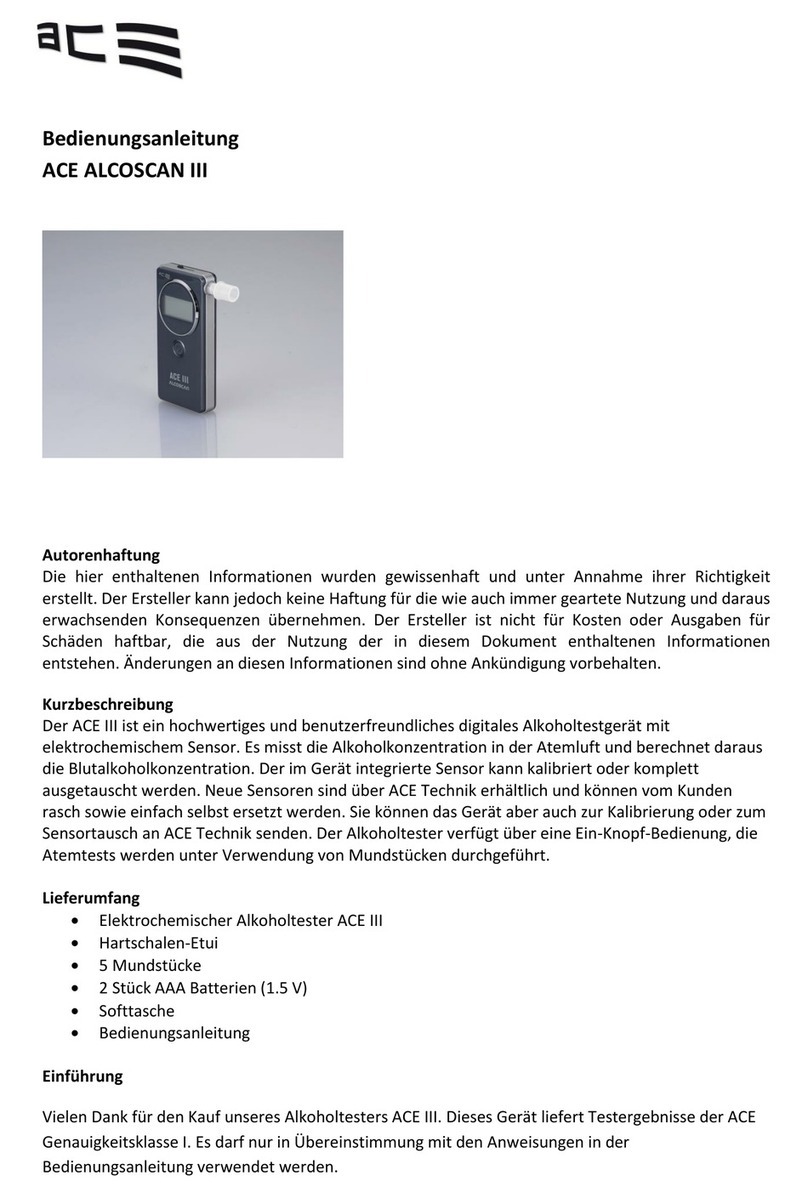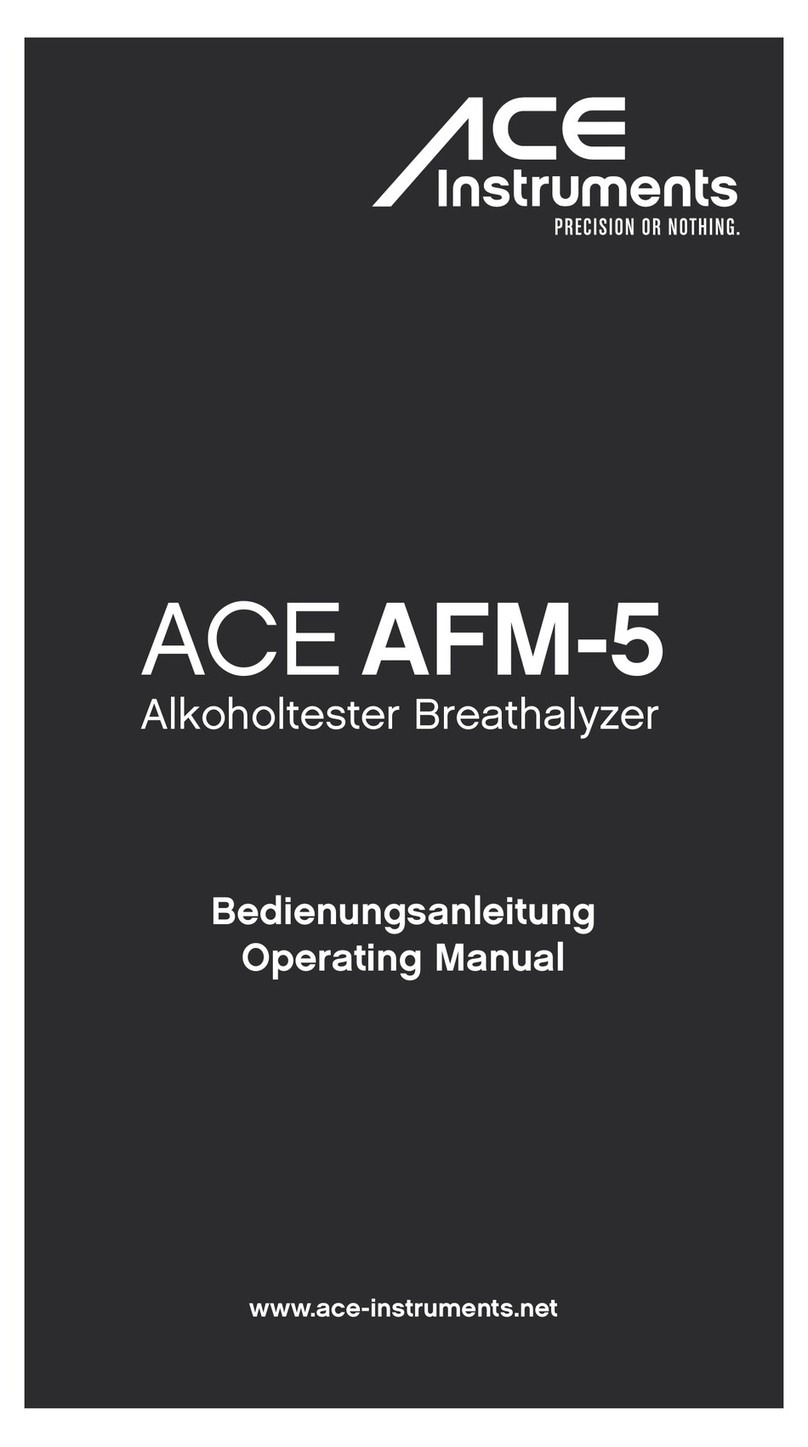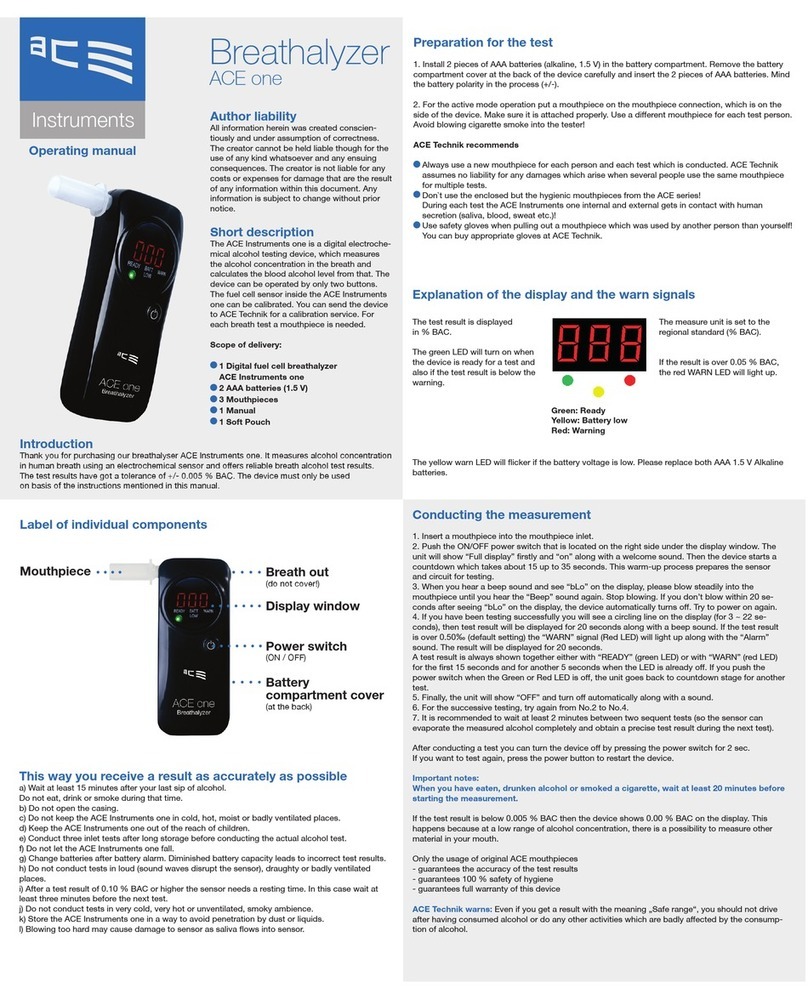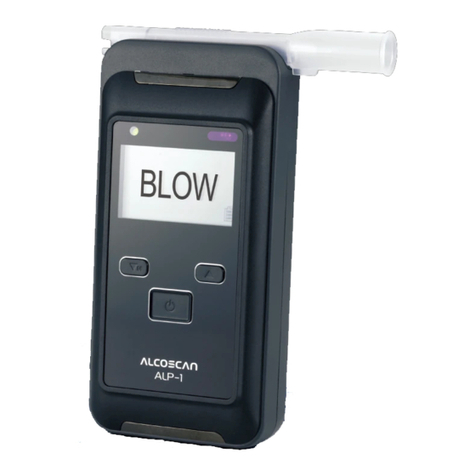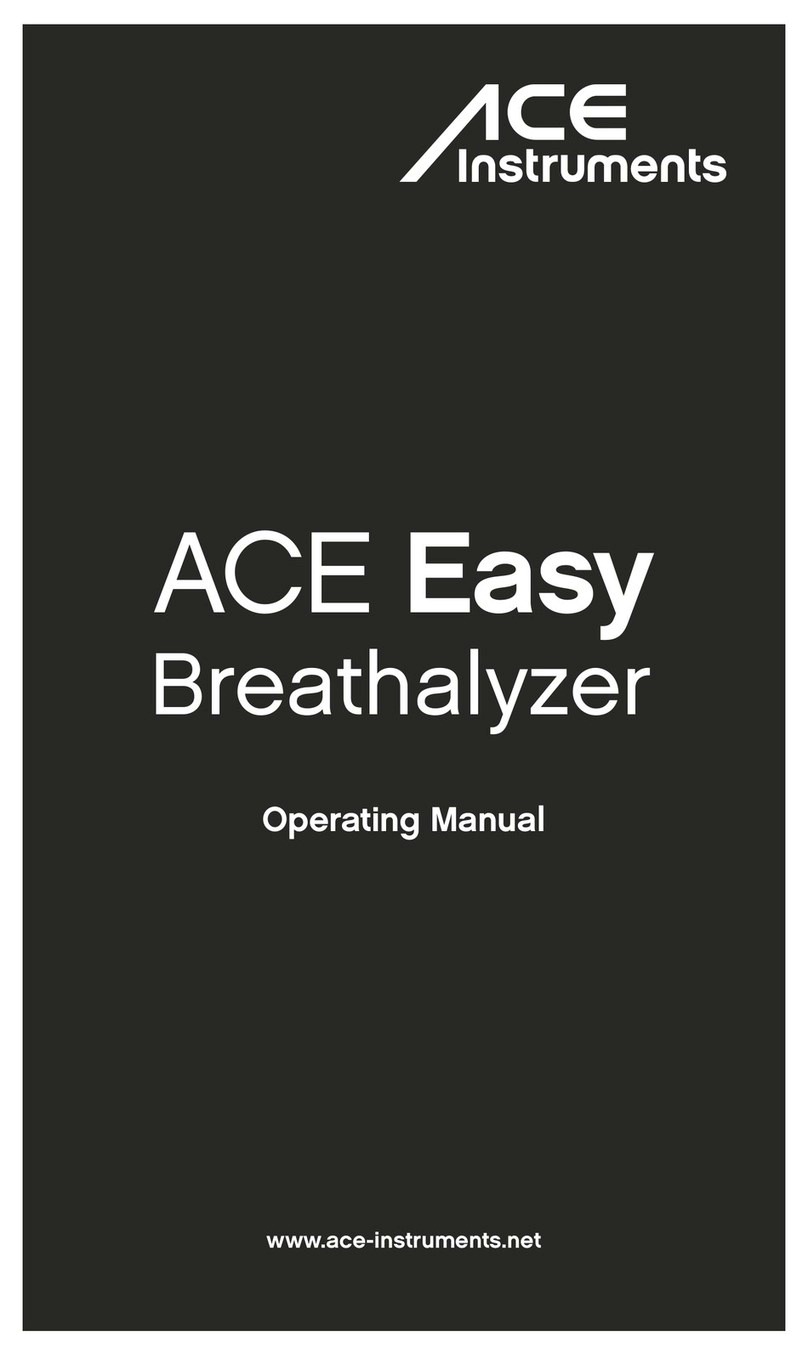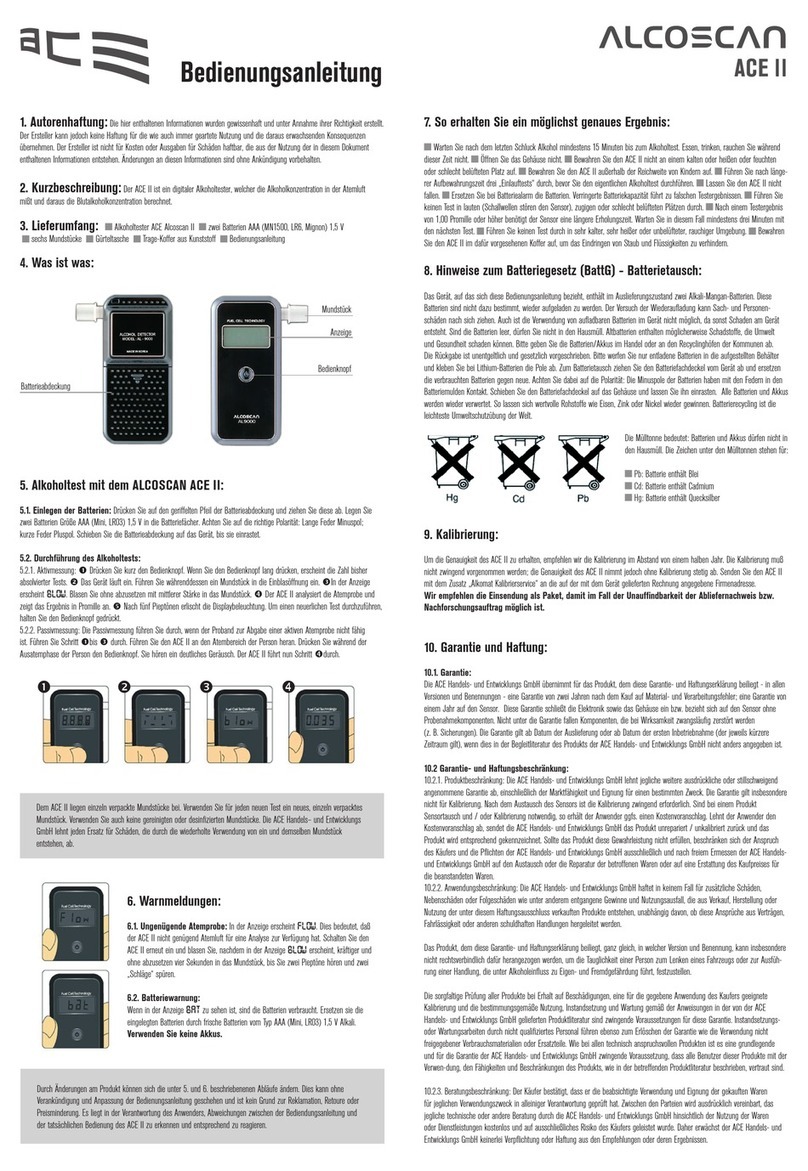
03 04
2. Danach ist ein zweiter Biepton zu
hören und es erscheint die Anzahl der
verbleibenden Tage bis zum nächsten
Kalibrierzeitpunkt. Wenn dieser
erreicht ist, so blinkt am linken und
rechten Display-Rand ein blaues Licht,
zusätzlich erscheint „CAL“ am Display.
3. Nach der Anzeige des Kalibrier-
zeitpunktes ist ein dritter Biepton zu
hören und das Gerät erwärmt sich
während eines Countdowns. Wenn
dieser die Zahl „2“ erreicht, so atmen
Sie zur Vorbereitung auf Ihre Atem-
probe tief ein.
4. Wenn der Countdown zu Ende
ist, dann hören Sie einen doppelten
Biepton und am linken Displayrand
erscheinen 3 Linien. Zusätzlich blinkt
das Wort „START“ am Display. Sie
können jetzt mit der Atemprobe
beginnen.
5. Pusten Sie jetzt ca. 5 Sekunden
konstant und ohne Pause bis Sie
einen Klackton und einen zweifachen
Biepton hören. Während der Atem-
probe ist ein andauernder Biepton zu
hören. TIPP: Pusten Sie bei der Atem-
probe so, also ob Sie ohne Ton pfeifen
würden. Wenn der Test erfolgreich
war, dann bewegen sich strichlinierte
Linien an der Ecke des Displays
(siehe Bild links). Die Anzeige „FLo“
bedeutet, dass Ihre Atemprobe nicht
ausreichend war. Drücken Sie noch-
mals 2 Sekunden lang den Startknopf
und starten Sie einen neuen Test.
6. Wenn die Atemprobe ausreichend
war, dann sehen Sie nach ein paar
Sekunden das blinkende Messergeb-
nis des geschätzten Alkoholgehaltes
in der Atemluft zirka 12 Sekunden lang
am Display. Sobald das Messergebnis
nicht mehr blinkt, können Sie einen
neuen Test starten. Drücken Sie
dazu wieder 2 Sekunden lang den
Startknopf.
So erhalten Sie ein möglichst genaues Ergebnis
A) Warten Sie nach dem letzten Schluck Alkohol mindestens
15 Minuten bis zum Alkoholtest. Essen, trinken und rauchen Sie
während dieser Zeit nicht.
B) Öffnen Sie das Gehäuse nicht.
C) Bewahren Sie den Alkoholtester nicht an einem kalten oder
heißen oder feuchten oder schlecht belüfteten Platz auf.
D) Bewahren Sie den Alkoholtester außerhalb der Reichweite
von Kindern auf.
E) Führen Sie nach längerer Aufbewahrungszeit drei „Einlauftests“
durch, bevor Sie den eigentlichen Alkoholtest durchführen.
F) Lassen Sie den Alkoholtester nicht fallen.
G) Ersetzen Sie die Batterie, wenn ihre Leistung schwach ist.
Verringerte Batteriekapazität führt zu falschen Testergebnissen.
H) Führen Sie keinen Test in lauten (Schallwellen stören den
Sensor), zugigen oder schlecht belüfteten Plätzen durch.
I) Nach einem Testergebnis von 1,00 Promille oder höher benö-
tigt der Sensor eine längere Erholungszeit. Warten Sie in diesem
Fall mindestens drei Minuten bis zum nächsten Test.
J) Führen Sie keinen Test durch in sehr kalter, sehr heißer oder
unbelüfteter, rauchiger Umgebung.
K) Bewahren Sie den Alkoholtester so auf, dass das Eindringen
von Staub und Flüssigkeiten verhindert wird.
L) Pusten Sie nicht zu stark in das Gerät, dies schadet dem
Sensor (vor allem, wenn durch das Pusten viel Speichel in das
Gerät gelangt).
Vorbereitung für den Test
1. Schieben Sie den Batteriefachdeckel (an der Rückseite des
Gerätes) nach unten und legen Sie die 2 im Lieferumfang ent-
haltenen AAA-Batterien (Alkaline, 1,5 V) in das Batteriefach ein.
Beachten Sie beim Einlegen und beim späteren Austausch von
alten gegen neue Batterien die Polarität (+/-) der Batterien.
2. Stecken Sie ein Mundstück auf die seitliche Öffnung zum
Anbringen der Mundstücke (= die Öffnung an der linken Seite
der Gerätefront). Vergewissern Sie sich, dass das Mundstück
festsitzt. Verwenden Sie für jede Testperson ein neues Mund-
stück (aus hygienischen Gründen und zum Erhalt der Messge-
nauigkeit, da ein benutztes Mundstück im Inneren Restalkohol
enthalten könnte).
Testdurchführung
1. Drücken Sie 2 Sekunden den
Startknopf (an der Vorderseite des
Gerätes) zum Einschalten, nach dem
Loslassen des Startknopfes ist ein
Biepton zu hören. Es erscheint kurz
die Gesamtanzahl der mit dem Gerät
bisher durchgeführten Tests.













